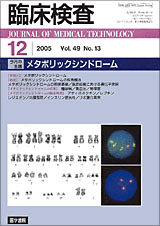文献詳細
文献概要
トピックス
注目されるヒトパピローマウイルス遺伝子型タイピング
著者: 髙橋正宜1
所属機関: 1(株)医学生物学研究所
ページ範囲:P.1730 - P.1734
文献購入ページに移動1.今なぜヒトパピローマウイルス遺伝子型タイピングか
子宮頸癌の罹患のリスクが若年層に上昇し,それが性行為によるヒトパピローマウイルス(HPV)感染の機会の増加に起因することが認識され,現在効果的子宮がん検診の対象が30歳以上から20歳以上に引き下げられて細胞診が推進されている.前癌病変から子宮頸癌への進展は遅く,早期発見による早期治療が必須であることは周知の事実で,精度管理の高い施設における細胞診の実施が厚生労働省のがん検診実施のための指針にも指摘されている.これには適正な精度保証を有する細胞診の標準化とHPV遺伝子型タイピング(genotyping)が重要な課題となってきた.具体的には細胞診標準化として適切な採取器具を用いて細胞を十分に収集し,固定保存できる液状細胞診(Liquid-based Cytology; LBC)が導入され,HPV genotypingにより高リスク型の感染か否かを診断し前駆病変の対策を講じることが効果的と考えられている.
2.細胞診におけるコイロサイトーシスとベセスダシステム
かつてHPV感染は外性器の尖圭コンジローマを意味し簡単な電気焼灼や凍結切除術で治療されていたが,子宮頸部に病変の頻度が高いflat condylomaの存在と細胞診による診断の重要性を強調し始めたのはMeisels, Fortinら1)(1976)で,超微形態的にウイルス粒子を立証したのはDellaTorreら2)(1978)である.Meiselsによれば軽度異形成low-grade squamous intraepithelial lesion(LSIL),CIN1として判定される症例の70%はHPV感染にかかわるもので,組織再生や炎症による増殖性変化が残りを占めるという.ベセスダシステム(Bethesda System)では再生や炎症による反応性病変をreactive changeとしてまとめ,また起因不明な核肥大などをASCUS(atypical squamous cells of undetermined significance)と命名し,これをLSILと区分しているが実際にはその判別にはgrey zoneのものが少なくない.日母分類IIIaも人により判定の変動が大きく広いスペクトラムを有している.べセスダシステムアトラス3)の図説に偽コイロサイトーシス(psudokoilocytosis)が記載され,核周囲明庭の境界が不明瞭な所見を反応性変化群に入れて辺縁が厚く境界明瞭な所見のものをHPVによるLSILとしているが遺伝子レベルの根拠を示して記載してはいない(図1~3).今やASCUS, LSILにわたる細胞病理学的変化に分子生物学的根拠を確認することが不可欠であり,genotypingによるリスク因子を知ることは治療目的から極めて重要な課題といえよう.
子宮頸癌の罹患のリスクが若年層に上昇し,それが性行為によるヒトパピローマウイルス(HPV)感染の機会の増加に起因することが認識され,現在効果的子宮がん検診の対象が30歳以上から20歳以上に引き下げられて細胞診が推進されている.前癌病変から子宮頸癌への進展は遅く,早期発見による早期治療が必須であることは周知の事実で,精度管理の高い施設における細胞診の実施が厚生労働省のがん検診実施のための指針にも指摘されている.これには適正な精度保証を有する細胞診の標準化とHPV遺伝子型タイピング(genotyping)が重要な課題となってきた.具体的には細胞診標準化として適切な採取器具を用いて細胞を十分に収集し,固定保存できる液状細胞診(Liquid-based Cytology; LBC)が導入され,HPV genotypingにより高リスク型の感染か否かを診断し前駆病変の対策を講じることが効果的と考えられている.
2.細胞診におけるコイロサイトーシスとベセスダシステム
かつてHPV感染は外性器の尖圭コンジローマを意味し簡単な電気焼灼や凍結切除術で治療されていたが,子宮頸部に病変の頻度が高いflat condylomaの存在と細胞診による診断の重要性を強調し始めたのはMeisels, Fortinら1)(1976)で,超微形態的にウイルス粒子を立証したのはDellaTorreら2)(1978)である.Meiselsによれば軽度異形成low-grade squamous intraepithelial lesion(LSIL),CIN1として判定される症例の70%はHPV感染にかかわるもので,組織再生や炎症による増殖性変化が残りを占めるという.ベセスダシステム(Bethesda System)では再生や炎症による反応性病変をreactive changeとしてまとめ,また起因不明な核肥大などをASCUS(atypical squamous cells of undetermined significance)と命名し,これをLSILと区分しているが実際にはその判別にはgrey zoneのものが少なくない.日母分類IIIaも人により判定の変動が大きく広いスペクトラムを有している.べセスダシステムアトラス3)の図説に偽コイロサイトーシス(psudokoilocytosis)が記載され,核周囲明庭の境界が不明瞭な所見を反応性変化群に入れて辺縁が厚く境界明瞭な所見のものをHPVによるLSILとしているが遺伝子レベルの根拠を示して記載してはいない(図1~3).今やASCUS, LSILにわたる細胞病理学的変化に分子生物学的根拠を確認することが不可欠であり,genotypingによるリスク因子を知ることは治療目的から極めて重要な課題といえよう.
参考文献
1) Meisels A, Fortin R:Condylomatous lesions of the cervix and vagina. Cytologic patterns. Acta Cytol 20:505-509, 1976
2) DellaTorre G, Pilloti S, dePalo G, et al:Viral particles in cervical condylomatous lesions. Tumori 64:549-553, 1978
3) Kurman RJ, Solomon D:The Bethesda System for reporting cervical/vaginal cytologic diagnoses. Springer Verlag, New York, 1994
4) Scheffner M, Huibregste JM, Vierstra RD, et al:The HPV16Eb and E6-AP complex functions as a ubiquitin protein ligase in the ubiquitination of p53. Cell 75:495-505, 1993
5) Dyson N, Howley PM, Munger R, et al:The human papillomavirus 16 E 7 oncoprotein in able to bind to the retinoblastoma gene product. Science 243:934-937, 1989
6) Durst M, Gissmann L, Ikenberg H, et al:A papillomavirus DNA from a cervical carcinoma and its prevalence in cancer biopsy samples from different geographic regions. Proc Natl Acad Sci 80:3812-3815, 1983
7) Boshart M, Gissmann L, Ikenberg H, et al:A new type of papillomavirus DNA and its presence in genital cancer biopsies and cell lines derived from cervical cancer. Embo J 3:1151-1157, 1984
8) Hesselink AT, van den Brule AJ, Brink AA, et al:Comparison of Hybrid Capture 2 with in situ hybridization for the detection of high-risk human papillomavirus in liquid-based cervical samples. Cancer 102:11-18, 2004
9) 白澤浩,関根大正,清水文七:ヒトパヒローマウイルス.先端技術を用いたSTDの臨床検査(髙橋正宜,武田敏編), pp82-92, 文光堂,1989
10) Monsonego J:HPV infections and cervical cancer prevention. Gynecol Oncol 96:830-839, 2005
11) Smith RA, Mettlin CJ, Davis KJ, et al:American Cancer Society Guidelines for the early deteclion of cancer. CA Cancer J Clin 50:34-49, 2000
12) Jenkins D, Sherlaw-Johnson C, Gallivan S:Assessing the role of HPV testing in cervical cancer screening. Papilloma Report 9:89-101, 1998
13) 石和久,喜納勝成,宇津野栄,他:ハイブリッドキャプチャー法によるHPV DNA検出キットのHPV感染症の診断における有用性.医学と薬学 39:849-853, 1998
14) Gravitt PE, Peyton CL, Apple RJ, et al:Genotying of 27 human papillomavirus types by using L1 consensus PCR products by single hybridization, reverse line blot detection method. J Clin Microbiol 36:3020-3027, 1998
15) Kornegay JR, Roger M, Davies PO, et al:International proficiency study of a consensus L1 PCR assay for the detection and typing of human papillomavirus DNA;evaluation of accuracy and intralaboratory and interlaboratory agreement. J Clin Microbiol 41:1080-1086, 2003
16) Cubie HA, Cuschieri KS, Zmijewski FM, et al:Evaluation of the sensitivity and specificity of the Roche AMPLICOR human papillomavirus (HPV) test, the Roche prototype line blot assay and the Digene Hybrid Capture 2 test for the detection of HPV in archived cervical samples with borderline cytology abstract at the 21st International Papillomavirus Conference and Clinical Workshop on February 20-26, Mexico City, 2004
17) Vernon SD, Unger ER, Williams D:Comparison of human papillomavirus detection and typing by cycle sequencing, line blotting and hybrid capture. J Clin Microbiol 38:651-655, 200
18) Cuschieri KS, Cubie HA, Whitley MW, et al:Multiple high risk HPV infections are common in cervical neoplasia and young women in a cervical screening population. J Clin Pathol 57:68-72, 2004
19) Clifford GM, Smith JS, Plummer M, et al:Human papillomavirus types in invasive cervical cancer worldwide;a metaanalysis. Brit J Cancer 88:63-73, 2003
20) 今野良,永井堅,永井宏,他:子宮癌検診.診断と治療 93:1575-1582, 2005
21) Boardman LA, Stanko C, Weitzen S, et al:Atypical squamous cells of undetermined significance;human papillomavirus testing in adolescents. Obstet Gynecol 105:741-746, 2005
22) Soloman D, Schiffman M, Tarone R:Comparison of three management strategies for patients with atypical squamous cells of undetermined significace;baseline results from a randomized trial. J Natl Cancer Inst 93:293-299, 2001
23) Wright TC, Cox JT, Massad LS, et al:2001 consensus guidelines for the management of women with cervical cytological abnormalities. JAMA 287:2120-2130, 2002
24) Lonky NM, Felix JC, Naidu YM, et al:Triage of atypical squamous cells of undetermined significance with hybrid capture II;colposcopy and histologic human papillomavirus correlation. Obstet Gynecol 101:481-489, 2003
掲載誌情報

